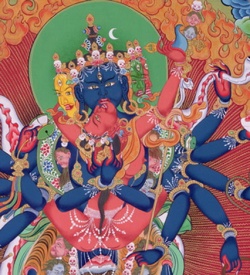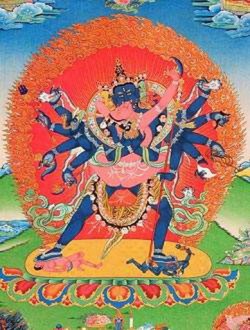Heruka Chakrasamvara
Buddha Shakyamuni manifests in the form of Heruka Chakrasamvara (Tib. korlo dompa) for the benefit of all beings and therefore he is considered the source of this high tantra.
Heruka Chakrasamvara (Skt; Tib: Kor-lo Dem-chog)
Male meditational deity from the mother tantra class of Highest Yoga Tantra. He is the principal deity connected with the Heruka Vajrasattva practice and was Lama Yeshe's yi-dam.
For Kagyu people, Tilopa the Mahasiddha -- the greatly accomplished 10th-century South Indian adept -- is an embodiment of this deity.
"Given that Tilopa was truly Chakrasamvara, then it would follow that Gonpo ChakZhipa, or the four-armed form of Mahakala, would be Tilopa, [ie.] Chakrasamvara in Mahakala-form.
(ChakZhipa is the wrathful protector emanation of Chakrasamvara, and is practiced by Karma Kagyu practitioners, usually those who have done some sort of retreat, esp. the three-year retreat based on the Kamtsang tradition. Dorje Bernakchen and Gonpo Chakdrupa are the more common Mahakala-forms practiced by Kagyu centers here in the West.)"
A deity associated with the Marpa the Translator and Milarepa and with the Kagyu denomination in particular, he is also important to Sakya practitioners, and also to the Gelugpa, who call him Heruka or Demchog.
Shamvara/shambara means ecstasy, the bliss that is the result of tantric practice. It is related to an epithet of the Hindu god, Lord Shiva, who is addressed as Shambo, usually translated, Auspicious One. In fact, Heruka's topknot is adorned with the moon -- the characteristic jewel adornment of Shiva, and in his activity form, he also holds, among other attributes, the characteristic trident.
The word heruka comes from Sanskrit and it signifies a semi-wrathful guardian. Used independently of any other name, it usually refers to Chakrasamvara. It is taught that each syllable represents Emptiness: He [pron. hei] is the nature of emptiness of all dharmas or phenomena, present here and now. Ru -- like the wind bowing through a channel -- the nature of emptiness of all beings, and Ka -- the union of bliss and emptiness.
The name Chakrasamvara means Supreme Bliss of the Wheel. The great Heruka is often depicted with four faces, twelve arms, and in union or complete embrace with his consort, Vajravarahi. He is blue-black.
His arms stand for the 12 links, or nidana, in the chain of causality. The three eyes stand for the three times and the four faces, the directions. The first pair of hands holds a vajra and bell symbolizing the union of skillful means and wisdom. The second pair rends the elephant hide of appearances, stretching the skin of illusion like a cloak.
A damaru (two-headed) drum in the third right hand shows that Samvara's "voice resounds joyously." The third left hand holds the khatvanga, a spear with three heads that represents "the blissful Thought of Enlightenment." His fourth right hand brandishes the axe that "cuts off birth and death at the roots."
The skull bowl of blood in his fourth left hand shows that he "has cut away
discrimination between existence and nonexistence." His fifth right hand wields the vajra cleaver that "cuts off the six defects, pride and the rest." The vajra lasso in his fifth left hand binds beings to wisdom from life to life. The trident in his sixth right hand signals that he has "overcome the evil of the threefold world." The severed head of the god Brahma dangles from his sixth left hand, showing that Samvara "avoids all illusion."
Shamvara is beyond both samsara and nirvana. To signify this, his right foot treads on Kalaratri (Darkest Night) representing nirvana and his left foot is on Bhairava, The Terrifier, sustainer of samsara (sansara).
Accomplished practitioners of the Heruka Tantra manifest different qualities especially the realization that all phenomena are one with the mind of Heruka, or the product of bliss and emptiness.
The mantra of Heruka is
OM SHRI VAJRA HE HE RU RU KAM HUM HUM P'HAT DAKINI DZALA SHAMBARAM SOHA
But this is for only one of the three main Chakrashamvara traditions: One comes down from Luipa, another is from Krishnapada, and there is also the two-fold system according to Ghantapa, which describes the inner and outer mandalas.
Vajrayogini is the name given to Heruka's consort, or Wisdom aspect.

